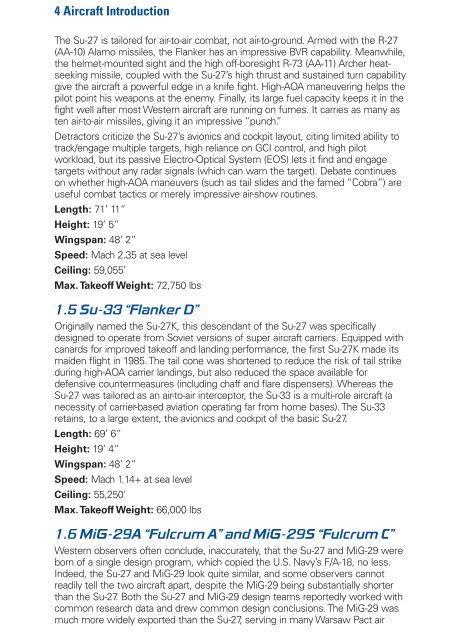Heads-Up Display Modes 35 - Metaboli
Heads-Up Display Modes 35 - Metaboli
Heads-Up Display Modes 35 - Metaboli
Create successful ePaper yourself
Turn your PDF publications into a flip-book with our unique Google optimized e-Paper software.
4 Aircraft Introduction<br />
The Su-27 is tailored for air-to-air combat, not air-to-ground. Armed with the R-27<br />
(AA-10) Alamo missiles, the Flanker has an impressive BVR capability. Meanwhile,<br />
the helmet-mounted sight and the high off-boresight R-73 (AA-11) Archer heatseeking<br />
missile, coupled with the Su-27’s high thrust and sustained turn capability<br />
give the aircraft a powerful edge in a knife fight. High-AOA maneuvering helps the<br />
pilot point his weapons at the enemy. Finally, its large fuel capacity keeps it in the<br />
fight well after most Western aircraft are running on fumes. It carries as many as<br />
ten air-to-air missiles, giving it an impressive “punch.”<br />
Detractors criticize the Su-27’s avionics and cockpit layout, citing limited ability to<br />
track/engage multiple targets, high reliance on GCI control, and high pilot<br />
workload, but its passive Electro-Optical System (EOS) lets it find and engage<br />
targets without any radar signals (which can warn the target). Debate continues<br />
on whether high-AOA maneuvers (such as tail slides and the famed “Cobra”) are<br />
useful combat tactics or merely impressive air-show routines.<br />
Length: 71’ 11”<br />
Height: 19’ 5”<br />
Wingspan: 48’ 2”<br />
Speed: Mach 2.<strong>35</strong> at sea level<br />
Ceiling: 59,055’<br />
Max. Takeoff Weight: 72,750 lbs<br />
1.5 Su-33 “Flanker D”<br />
Originally named the Su-27K, this descendant of the Su-27 was specifically<br />
designed to operate from Soviet versions of super aircraft carriers. Equipped with<br />
canards for improved takeoff and landing performance, the first Su-27K made its<br />
maiden flight in 1985. The tail cone was shortened to reduce the risk of tail strike<br />
during high-AOA carrier landings, but also reduced the space available for<br />
defensive countermeasures (including chaff and flare dispensers). Whereas the<br />
Su-27 was tailored as an air-to-air interceptor, the Su-33 is a multi-role aircraft (a<br />
necessity of carrier-based aviation operating far from home bases). The Su-33<br />
retains, to a large extent, the avionics and cockpit of the basic Su-27.<br />
Length: 69’ 6”<br />
Height: 19’ 4”<br />
Wingspan: 48’ 2”<br />
Speed: Mach 1.14+ at sea level<br />
Ceiling: 55,250’<br />
Max. Takeoff Weight: 66,000 lbs<br />
1.6 MiG-29A “Fulcrum A” and MiG-29S “Fulcrum C”<br />
Western observers often conclude, inaccurately, that the Su-27 and MiG-29 were<br />
born of a single design program, which copied the U.S. Navy’s F/A-18, no less.<br />
Indeed, the Su-27 and MiG-29 look quite similar, and some observers cannot<br />
readily tell the two aircraft apart, despite the MiG-29 being substantially shorter<br />
than the Su-27. Both the Su-27 and MiG-29 design teams reportedly worked with<br />
common research data and drew common design conclusions. The MiG-29 was<br />
much more widely exported than the Su-27, serving in many Warsaw Pact air















